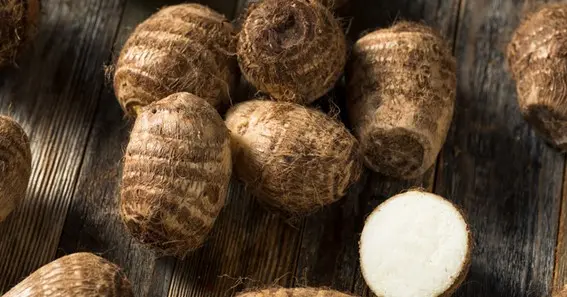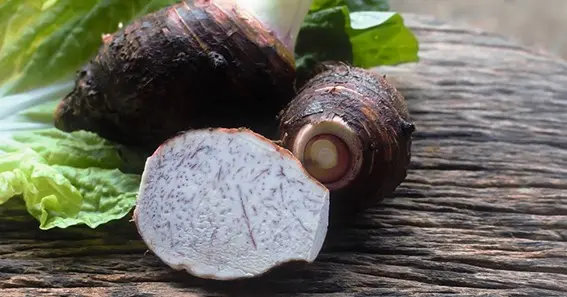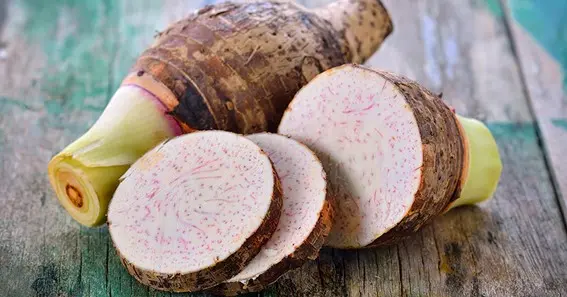What is taro? Taro is a tropical root vegetable, it has a lot of uses and is essential to many cultures. Skin is dark and fuzzy; flesh is purple and starchy. Asian, yet it has crossed seas to become a staple in many meals worldwide. Many sweet and spicy dishes incorporate this ingredient because of its nutty flavor and nutritional value.
What Is Taro?
Taro is a root vegetable that is the most frequently farmed species of Araceae plants. It is utilized for their corms, leaves, stems, and petioles. This plant thrives in rainy tropical or subtropical climates. Taro grows well in moist areas (called “paddies”) or well-drained uplands. Most roots have a dark, thick epidermis that covers a starchy, cream-colored, or pale purple-flecked interior. Big, heart-shaped taro leaves are edible. Kitchens use them to remove hazards after cooking. Taro’s vitamins, minerals, and fiber make it healthy. Explore the best thing about What is taro.
Tropical root food taro is healthy in many ways. Its fiber, vitamins, and minerals benefit your heart, immune system, and intestines. You may make sweet and spicy meals using it, such as soups, stews, and pastries. Taro has always been famous with people from many places and cuisines.
Health Benefits Of Taro

Many people like Taro because it is healthy and contains protein, vitamins, and minerals. It is suitable for your gut and helps keep your blood sugar levels healthy because it has a lot of protein. Carrots also have vitamins E, C, and B6 that are good for your health and nervous system. Minerals like potassium, magnesium, and iron help the body do many things, like keeping the heart healthy and using energy well. Lets discuss with What is taro and health benefits.
Uses Of Taro In Cooking
There are many ways to cook Taro, which has a unique taste. It gives both sweet and savory recipes a distinctive nutty flavor and a creamy texture. The thick meat of Taro is excellent for soups, stews, sauces, and stir-fries because it soaks up flavors and makes the whole dish taste better. You can cook, mash, or puree it to make smooth sauces or sweets.
How Is Taro Connected To Hawaii?

What is Taro means to people who grow it is very traditional. The Hawaiians pound taro into a paste and mix it with water to make poi, an old favorite. Poi is a main dish in Hawaii and an important part of their traditions, beliefs, and healing practices. For the same reason, Taro is a big part of holidays and traditions in other parts of the world, where it stands for plenty, fertility, and wealth.
Where Is Taro Cultivated?
It rains a lot and gets warm there, where Taro grows best. Farmers usually grow it in flood-damaged areas, where the water keeps the plants at the right temperature and feeds them. Based on the type and the weather, taro farming needs anywhere from seven to twelve months to grow. Farmers in wet places often grow Taro as a crop because it does well in bad weather and makes a lot of food.
Farmers believe that growing Taro is environmentally friendly, mainly when they use old-fashioned methods that make the fields look like they are in the wild. Over time, wet taro fields can be suitable for the land and help different kinds of life thrive. For taro farming to last a long time, though, new ways of farming need to find ways to deal with issues like disease and environmental damage.
How Important Is Taro For Business?
A lot of places grow Taro because it makes a lot of money. A food crop and a business product are the two ways to use it. It helps small farmers make a living and ensures that people in warm and subtropical places always have food. More people around the world want Taro and things made from it. Taro growing is an integral part of farming systems worldwide because it allows local economies, creates jobs, and brings in money for everyone.
Conclusion
You can see that what is Taro is more than just a green root. It is a cultural sign, a superfood, and a versatile food. While we enjoy how practical and hardy Taro is, let’s remember how important it is to grow in a way that doesn’t hurt the earth so that future generations can also use this excellent plant—people still like Taro, which shows how useful and attractive it is. For years to come, people all over the world will eat it.
FAQ
What Good Things About Taro For Your Health?
Foods like Taro contain minerals, vitamins, and fiber that help your body digest food better, stay healthy, and fight off sickness. Because it has a lot of vitamins, it also helps keep you from getting long-term illnesses.
What Kinds Of Foods Can You Make With Taro?
Numerous people prepare and eat Taro in various ways. It is an essential part of ginataang bilo-bilo in the Philippines, Hawaiian poi, and Cuban callaloo. You can boil, cook, bake, or fry it. You can also use it on snacks and toppings.
When Making Taro, What Should You Keep In Mind?
Because calcium oxalate can be irritating to the skin, it is very important to cook the Taro all the way through. Many people cook by boiling, heating, or baking. Take the time to peel and cut the Taro into pieces before you cook it.
What Kinds Of Potatoes Are There?
Many people eat Dasheen, Eddoe, and Bun Long taro. Each type’s sizes, colors, and textures are different, and each has its own tastes and food uses. These types are suitable for many kinds of foods and nutrition needs.
What Does Hawaiian Culture Have To Do With Taro?
Hawaii sees Taro as more than just a food. It is also a spiritual and cultural symbol. Poi is a food that comes from Hawaii and is very important in healing and ceremonies. Hawaii people think Taro is holy and a big part of their society.
Is Taro Poisonous If Consumed Raw?
No, Taro will not harm humans if it is consumed raw but that might cause prickle in the mouth or throat.
Sources:
https://en.wikipedia.org/wiki/Taro
https://www.allrecipes.com/article/what-is-taro
https://www.foodnetwork.com/how-to/packages/food-network-essentials/what-is-taro






